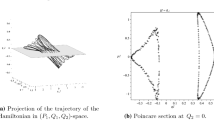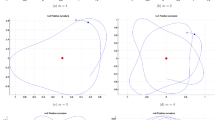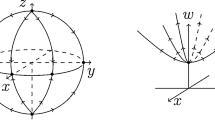Abstract
The idea that geometry and physics are intimately related made its way in human thought during the early part of the nineteenth century. Gauss measured the angles of a triangle formed by three mountain peaks near Göttingen, Germany, apparently hoping to learn whether the universe has positive or negative curvature, but the inevitable observational errors rendered his results inconclusive [3]. In the 1830s, Bolyai and Lobachevsky took these investigations further. They independently addressed the connection between geometry and physics by seeking a natural extension of the gravitational law from Euclidean to hyperbolic space. Their idea led to the study of the Kepler problem and the 2-body problem in spaces of nonzero constant Gaussian curvature, κ ≠ 0, two fundamental problems that are not equivalent, unlike in Euclidean space. A detailed history of the results obtained in this direction since Bolyai and Lobachevsky can be found in [3, 5, 6].
Access provided by Autonomous University of Puebla. Download conference paper PDF
Similar content being viewed by others
Keywords
These keywords were added by machine and not by the authors. This process is experimental and the keywords may be updated as the learning algorithm improves.
The idea that geometry and physics are intimately related made its way in human thought during the early part of the nineteenth century. Gauss measured the angles of a triangle formed by three mountain peaks near Göttingen, Germany, apparently hoping to learn whether the universe has positive or negative curvature, but the inevitable observational errors rendered his results inconclusive [3]. In the 1830s, Bolyai and Lobachevsky took these investigations further. They independently addressed the connection between geometry and physics by seeking a natural extension of the gravitational law from Euclidean to hyperbolic space. Their idea led to the study of the Kepler problem and the 2-body problem in spaces of nonzero constant Gaussian curvature, κ ≠ 0, two fundamental problems that are not equivalent, unlike in Euclidean space. A detailed history of the results obtained in this direction since Bolyai and Lobachevsky can be found in [3, 5, 6].
It is important to emphasize the reasons why this approach provides a natural way of extending gravitation to spaces of constant Gaussian curvature, since there is no unique way of generalizing the classical equations of motion in order to recover them when the curved ambient space becomes flat. As there are no physical experiments that could test the validity of the potential, we have to rely on a mathematical approach. The potential we want to use should thus satisfy the same basic properties the Newtonian potential does in its most basic setting: the Kepler problem—the particular case when one body moves around a fixed attracting centre.
Two fundamental properties characterize the Newtonian potential of the Kepler problem: it is a harmonic function in 3D (but not in 2D), i.e., it satisfies Laplace’s equation; and it generates a central field in which all bounded orbits are closed, a result proved by Joseph Louis Bertrand in 1873. In the early years of the twentieth century, Heinrich Liebmann proved that these properties are also satisfied by the Kepler problem in spaces of constant curvature, thus offering strong arguments for this mathematical generalization of the gravitational force.
In some recent studies, such as [1–13, 15, 16], we introduced a suitable framework for generalizing the equations of motion suggested by Bolyai and Lobachevsky to n ≥ 2 bodies. Like the curved Kepler problem and the curved 2-body problem, our equations made sense in spaces of constant Gaussian curvature κ ≠ 0, i.e., on 3-spheres of radius R = κ −1∕2 embedded in \(\mathbb{R}^{4}\), for κ > 0, and on hyperbolic 3-spheres of imaginary radius iR = κ −1∕2 embedded in the Minkowski space \(\mathbb{R}^{3,1}\), for κ < 0. But whether written in extrinsic or intrinsic coordinates, these equations contain undetermined expressions for κ = 0, although we can recover the classical Newtonian system when κ → 0. So a study of the flat case in the context of curved space, including some understanding of the bifurcations and the stability of solutions when the parameter κ is varied through 0, is impossible to perform in that setting.
In this study we derive some equations of motion that overcome the difficulties mentioned above. Using a coordinate system in \(\mathbb{R}^{4}\) having the origin at the North-Pole of the 3-spheres (the only point that is common to all the manifolds involved), we prove that the n-body problem in spaces of constant Gaussian curvature \(\kappa \in \mathbb{R}\) can be written as
where m 1, m 2, …, m n > 0 represent the masses, the dot ⋅ denotes the standard inner product of signature (+, +, +, +) for κ ≥ 0, but the Lorentz inner product of signature (+, +, +, −) for κ < 0, the vectors R and r i are given by
\(\sigma\) is the signum function, i.e., \(\sigma = +1\) for κ ≥ 0 and \(\sigma = -1\) for κ < 0, and
is the Euclidean distance for κ ≥ 0 and the Minkowski distance for κ < 0.
Notice that the distances r ij vary smoothly with κ. In particular, the values of the coordinates ω i , i = 1, …, n, and consequently the values of the expressions (ω i −ω j )2, i, j ∈ { 1, 2, …, n}, i ≠ j, become small when κ gets close to 0 and vanish at κ = 0.
For κ ≠ 0, the initial conditions must be taken such that the bodies are restricted to 3-spheres for κ > 0 and hyperbolic 3-spheres for κ < 0. For κ = 0 and r i = (x i , y i , z i , 0), i = 1, …, n, we recover the Newtonian equations,
To make system (1) analytic for all values of the parameter, we can introduce the substitution \(\delta =\sigma \vert \kappa \vert ^{1/2}\). This slight modification of the equations of motion will be helpful in future studies of the bifurcations of solutions when the new parameter passes through the value δ = 0.
A potential application of these equations is that of establishing the geometric nature of the physical space. Physicists agree that the large-scale universe has constant curvature, κ, but it is not known whether this curvature is positive, negative, or zero. All experiments, however, show that | κ | must be very small. If the study of system (1) shows that some types of solutions exist only for one kind of curvature, but not for the other two kinds, and if the corresponding orbits prove to be stable, then we might find such motions in the universe through astronomical observations. If we do, then the physical space must necessarily have that kind of curvature.
So far we have proved that Lagrangian orbits (3-body motions for which the masses lie at the vertices of a rotating equilateral triangle) must have equal masses if κ ≠ 0, [14], a fact that is not true for κ = 0. Such non-equal mass orbits have been found in the solar system, for example Sun, Jupiter, and any of the Trojan asteroids. But we cannot yet conclude that space is flat. Motions very close to Lagrangian orbits might exist for κ ≠ 0; nobody, however, has proved or disproved their existence yet.
References
F. Diacu, “On the singularities of the curved n-body problem”. Trans. Amer. Math. Soc. 363(4) (2011), 2249–2264.
F. Diacu, “Polygonal homographic orbits of the curved 3-body problem”. Trans. Amer. Math. Soc. 364 (2012), 2783–2802.
F. Diacu, “Relative equilibria of the curved n-body problem”. Atlantis Studies in Dynamical Systems 1, Atlantis Press, Amsterdam, 2012.
F. Diacu, “The non-existence of the center-of-mass and the linear-momentum integrals in the curved n-body problem”. Libertas Math. 32(1) (2012), 25–37.
F. Diacu, “Relative equilibria of the 3-dimensional curved n-body problem”. Memoirs Amer. Math. Soc. 228 (2013), 1071.
F. Diacu, “The curved n-body problem: risks and rewards”. Math. Intelligencer 35(3) (2013), 24–33.
F. Diacu and S. Kordlou, “Rotopulsators of the curved n-body problem”. J. Differential Equations 255 (2013), 2709–2750.
F. Diacu, R. Martínez, E. Pérez-Chavela, and C. Simó, “On the stability of tetrahedral relative equilibria in the positively curved 4-body problem”. Physica D 256–257 (2013), 21–35.
F. Diacu, E. Pérez-Chavela, and M. Santoprete, “Saari’s conjecture for the collinear n-body problem”. Trans. Amer. Math. Soc. 357(10) (2005), 4215–4223.
F. Diacu and E. Pérez-Chavela, “Homographic solutions of the curved 3-body problem”. J. Differential Equations 250 (2011), 340–366.
F. Diacu, E. Pérez-Chavela, and J.G. Reyes Victoria, “An intrinsic approach in the curved n-body problem. The negative curvature case”. J. Differential Equations 252 (2012), 4529–4562.
F. Diacu, E. Pérez-Chavela, and M. Santoprete, “The n-body problem in spaces of constant curvature. Part I: Relative equilibria”. J. Nonlinear Sci. 22(2) (2012), 247–266.
F. Diacu, E. Pérez-Chavela, and M. Santoprete, “The n-body problem in spaces of constant curvature. Part II: Singularities”. J. Nonlinear Sci. 22(2) (2012), 267–275.
F. Diacu and S. Popa, “All the Lagrangian relative equilibria of the curved 3-body problem have equal masses”. J. Math. Phys. 55 (2014), 112701.
F. Diacu and B. Thorn, “Rectangular orbits of the curved 4-body problem”. Proc. Amer. Math. Soc. 143(4) (2015), 1583–1593.
E. Pérez-Chavela and J.G. Reyes Victoria, “An intrinsic approach in the curved n-body problem. The positive curvature case”. Trans. Amer. Math. Soc. 364(7) (2012), 3805–3827.
Author information
Authors and Affiliations
Corresponding author
Editor information
Editors and Affiliations
Rights and permissions
Copyright information
© 2015 Springer International Publishing Switzerland
About this paper
Cite this paper
Diacu, F. (2015). The Newtonian n-Body Problem in the Context of Curved Space. In: Corbera, M., Cors, J., Llibre, J., Korobeinikov, A. (eds) Extended Abstracts Spring 2014. Trends in Mathematics(), vol 4. Birkhäuser, Cham. https://doi.org/10.1007/978-3-319-22129-8_4
Download citation
DOI: https://doi.org/10.1007/978-3-319-22129-8_4
Publisher Name: Birkhäuser, Cham
Print ISBN: 978-3-319-22128-1
Online ISBN: 978-3-319-22129-8
eBook Packages: Mathematics and StatisticsMathematics and Statistics (R0)




